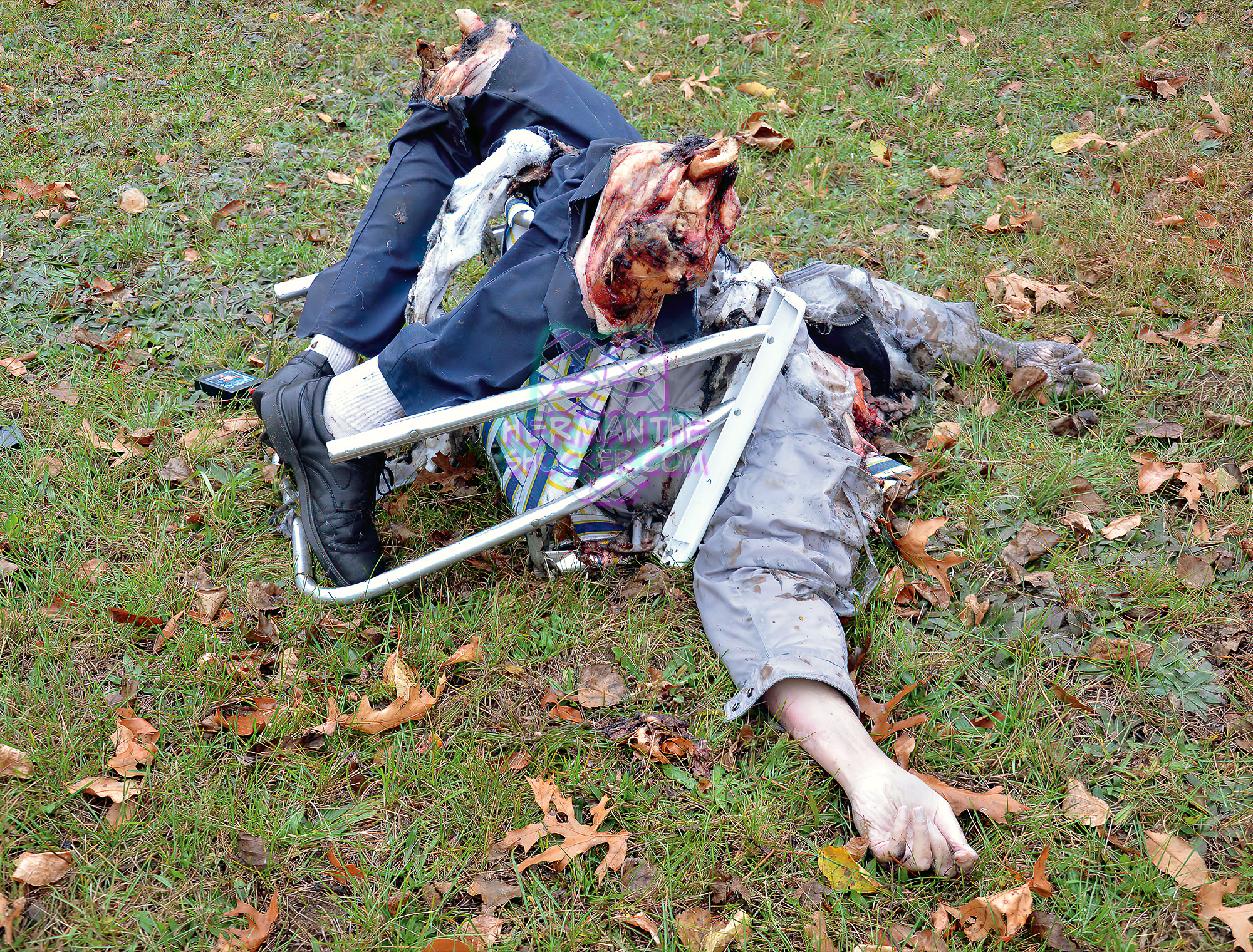Mishawaka, Indiana, US. In the fall of 2011, the badly injured body of a 65-year-old male was found on its back in the backyard of his home (Figs.1-3). A suicide note was found in the home, which indicated that the decedent wanted to “take the quick way out” of life, saying that he was depressed and in pain. Investigative information confirmed that the man was a military veteran with training in explosives. The victim’s neighbors and brother, who contacted police as they had not heard from him in some time, explained that the decedent was constantly using explosives. The neighbors had mentioned that four days prior, they had heard and felt the biggest explosion they had ever heard from his property but had not contacted anyone since he was always blowing things up.
Upon arrival at the scene and discovery of the body, police were initially concerned about additional explosive devices, as the decedent had previously expressed anti-government sentiment. This fear was heightened by the presence of a hand-held remote detonator device and another electrical device at the scene. As a result, the bomb squad was called and a robot was used to closely examine the remains and the scene prior to moving the body (Fig.4). There were no more explosives found near the body, but unarmed explosives were found in the decedent’s residence and disposed of at the scene.
Autopsy examination revealed a well-developed, well-nourished, male whose appearance was altered by severe injury. Radiographs revealed extensive skeletal trauma to the upper torso, with absence of head and neck structures as well as fractures about the knees. There was no radio-opaque foreign material/shrapnel evident by radiographic exam. Explosive-type defects were noted on the upper aspects of the torso clothing, as well as on the knee portions of the pants. The head and neck were absent and there was extensive damage to the upper torso (Fig.5).
The anterior and posterior skin of the upper chest and shoulders demonstrated irregularly jagged borders with areas of soot and charring focally. The soft and bony tissues underlying the borders were markedly damaged by presumed explosive injuries. There were rare abrasions and contusions of the chest and upper extremities. The lower extremities demonstrated rare abrasions and contusions as well as severe lacerations of the anteromedial knees with underlying fractures of the distal aspects of the femora (Fig.6). Within the depths of the knee wounds, there was soot and charring noted.
On internal exam, portions of the heart and lungs were evident within the chest cavity but were severely pulverized due to extensive blast-type injuries; the diaphragm was lacerated bilaterally and extensive pulverization-type injuries affected the liver as well (Fig.7). The upper esophagus, aortic arch, trachea, and main-stem bronchi were absent. The descending thoracic aorta and lower esophagus demonstrated lacerations. The clavicles were not readily identified, while the sternum, both scapulae, and ribs 1 through 10 bilaterally showed numerous fractures; the vertebral column was absent above the level of thoracic vertebral body 6 (Fig.8).
There was a laceration of the left flank, from which a portion of the small intestine protruded. Rare contusions of the small intestines, transverse colon, and mesentery were evident. Although there was evidence of apparent charring focally on the clothing and skin, there was no visibly identifiable foreign material evident. Swabbings of the hands and injured tissue margins were collected and retained (Fig.9). The clothing was retained as well (Fig.10).
Because of the extent of injury, there was virtually no blood remaining in the body; therefore, blood toxicology testing could not be performed. A urine drug screen tested positive for opiates, acetaminophen, topiramate, norcyclobenzprine, and dihydrocodeine. The body was only tentatively identified at the time of autopsy, based on circumstance. Subsequent positive identification was made by fingerprint comparison. The cause of death was explosion/blast injuries from a bomb. The manner of death was suicide.
Reconstruction of the event suggested that the decedent sat in a lawn chair, placed the explosive device between his knees, and leaned forward, with his head close to the device. The decedent had apparently purposefully kept his hands/fingers away from the explosion, apparently knowing that visual identification would be impossible after the explosion, but fingerprint comparison would be possible. As the case was deemed an obvious suicide by the coroner and police investigators, no further testing was undertaken to determine the exact nature of the explosives used in this event. As such, despite the collection of trace evidence and clothing, no further examination was performed.
Suicidal explosions are rarely encountered in the United States, although in some places worldwide, suicidal terrorist bombings are encountered to some degree of regularity, and the nonterrorist variety may be more common in other nations. Many of the reported cases of suicide by explosives report destruction of the head; however, rarely do they result in complete decapitation. While suicidal deaths related to explosives are not common, it is important that forensic pathologists and death investigators be aware of the characteristics of explosives-related deaths.

News report
Neighborhood evacuated again as bomb squad destroys explosives
ABC57.com – Oct 26, 2011
A 65-year-old Vietnam veteran, S. W. W., committed suicide by blowing himself up. He lived at 55527 Currant Road in Mishawaka. Police were asked to check on W.’s welfare by his concerned brother who had not seen him in several days. When police arrived on the scene, they discovered that W. had used an explosive device to kill himself.
Police say they found more explosives on his property and inside W.’s home. The bomb squad was on the scene for several hours Wednesday. County police evacuated the neighborhood between Early and Willow Creek. St. Joseph County Police had shut down Currant Road completely from Day to McKinley; they later allowed evacuated residents to return to their homes for the night.
Only residents of homes between Early and Willow Creek were allowed into the area. They were instructed to be out of the area no later than 8 a.m. on Thursday so bomb technicians could finish removing and destroying explosive materials found in the home. Bomb squads from South Bend and Elkhart found a lot of explosive materials in W.’s home, according to police. Some of the material was extremely dangerous and could be set off with as little as a spark from static electricity.
Police say a suicide note was found at the scene and they do not believe W. had any intentions of harming anyone but himself. W. had experience working with pyrotechnics, according to his brother. W. was said to have used his knowledge and skills to create fireworks shows and other explosive displays. Some neighbors say they heard a loud explosion Monday, and several say they felt it shake their home.
Neighbors say that Mr. W.’s home was recently sold at a tax sale. ABC 57 News checked with the St. Joseph County Auditor’s office. This is not true. However, he did have a quarrel with the county over his property taxes this past spring. Several deductions had dropped off of his account after Mr. W.’s wife passed away, which tripled his tax bill.
The taxes went unpaid and were delinquent for some time. Mr. W. took the matter up with the county, who who eventually corrected the tax bill. Mr. W. did eventually pay his tax bill. The property taxes on the home are current. W. was a long-time member of the Mishawaka VFW post #360 on Jefferson Blvd. He became a lifetime member in 1993.
News report
Police: Man committed suicide using explosives
WTHR.com – Oct 26, 2011
MISHAWAKA – Police say a 65-year-old Mishawaka man who made his own fireworks and frequently set off explosions on his 5-acre property apparently used a homemade explosive device to kill himself.
St. Joseph County police Sgt. Matt Blank says a brother of S. W. called police Wednesday asking police to check on him. The brother told police W. had been depressed and his family hadn’t heard from him in several days. W.’s body was found behind his garage.
Blank says police aren’t sure when W. died because of conflicting reports from neighbors about when they last heard an explosion. Blank says evidence indicates the death was a suicide, not an accident, but he declined to elaborate. He says the bomb squad found additional explosives on the property.
Latest posts
















 US ☎︎ 988 or 1-800-273-TALK (8255)
US ☎︎ 988 or 1-800-273-TALK (8255) CA ☎︎ 1-833-456-4566
CA ☎︎ 1-833-456-4566 UK ☎︎ 0800-689-5652
UK ☎︎ 0800-689-5652 AUS ☎︎ 13-11-14 or 1300-659-467
AUS ☎︎ 13-11-14 or 1300-659-467 ROK ☎︎ 1393
ROK ☎︎ 1393 DE ☎︎ 0800-111-0-111
DE ☎︎ 0800-111-0-111 ES ☎︎ 024
ES ☎︎ 024




